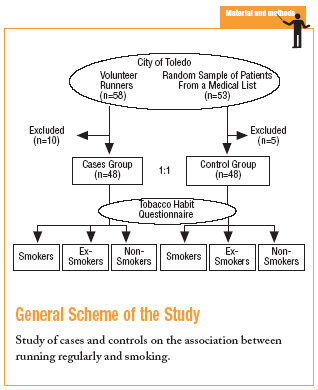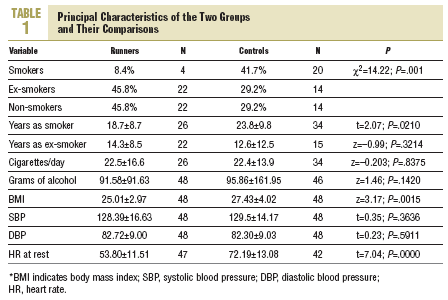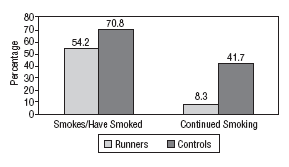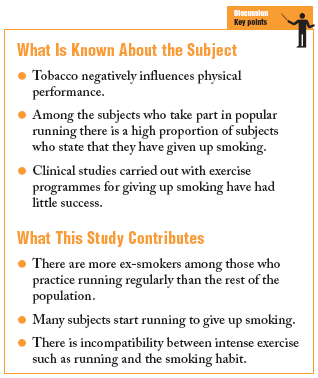1:1 pairing. Retrospective longitudinal observational study. Setting. Primary care. City of Toledo, Spain. Participants. Cases: 48 healthy volunteer runners of 47±7.8 years of age. Controls: 48 healthy subjects, paired by gender and year of birth, chosen at random from the medical list assigned to the medical researcher. Principal measurements. Smoking habits and alcohol consumption in grams per week using a questionnaire, weight, height, blood pressure, and heart rate at rest. The odds ratio (OR) was obtained on the proportion of subjects who smoked or smoked at some time, those who continued smoking and the probabilities of giving up tobacco in each group. Results. The OR of the proportion of subjects who smoked or had smoked between the groups of runners (54.2%) and controls (70.9%) was 0.486 (95% confidence interval [CI], 0.205-1.149; *2=2.8; P=.093). The OR for continuing the habit between groups of runners (8.4%) and controls (41.7%) was 0.127 (95% CI, 0.035-0.456; *2=14.0; P=.0002). In the group of runners, 45.8% had stopped smoking, as well as 31.2% of the controls (OR=7.85; 95% CI, 1.89-32.52; *2=11.8; P=.0007); 50% of the runners who smoked had given it up since starting to run and 76.9% of these had given it up just at the time of starting to run. Conclusions. There is a negative association between running and tobacco. If a smoker decides to run regularly he/she has high probabilities of giving up smoking and continue to do so.
Introduction
Tobacco appears to have an adverse effect on sports performance1 and, although in intense efforts the effects of nicotine on the body at rest appear to be neutralised,2 the rest of the adverse effects on physical performance is more obvious with the increase in the intensity of the effort.3
Accordingly, it appears that running, which is an intense effort, should be incompatible with the tobacco habit and could be used as an aid to quit smoking. However, there are few studies on the association between running and the tobacco habit. Only 2 transverse observational studies4,5 have been published on this association, carried out on participants in running track competitions. In the first,4 428 Swiss women runners, participants in a popular run of 16 km, were studied by means of a questionnaire and a positive association was found between the running habit and giving up smoking, although the aim of the study was not looking for this association. In the second,5 688 men and 725 women from the United States were studied, participants in a
10 km running competition, by means of a questionnaire, with an objective that was not looking for this association, although it did find that 81% of the men and 75% of the women who smoked when they started to run had given up smoking when they started to practice recreational running. Also, among those who continued running one year later (89% of the men and 79% of women), it was significantly more common to have given up smoking than it was between those who had now stopped running.
Therefore, there is no study which has specifically investigated the influence that the habit of running regularly can have on the smoking habit.
In view of all this, the objective of the present study was to investigate the influence of running on the tobacco habit, with the hypothesis that people who run regularly smoke less and to run helps them give up smoking.
Sujects and Methods
Design and Scope of the Study
It is an observational, longitudinal, and retrospective case and control study, with 1:1 pairing, carried out in the city of Toledo, Spain.
Study Population
Volunteers from a recreational running association, where a medical examination was performed which included questions on life habits (tobacco, alcohol and exercise, and measurements of weight, height, blood pressure, and heart rate at rest, with the inclusion of 58 runner subjects. Of these, 10 were excluded due to a history of high blood pressure (3 subjects), diabetes (4 subjects), cardiac disease (2 subjects), or who had been running for less than 1 year (1 subject). Of these 10, 8 were ex-smokers and 2 were non-smokers. Therefore, this left 48 health runner subjects to make up the cases group.
The control group was made up of healthy subjects, paired by gender and year of birth, chosen at random (using a random number table) from the patient population assigned to the study medical researcher. Of the subjects initially chosen, 5 were excluded, due to chronic obstructive pulmonary disease (COPD) (1 subject), high blood pressure (HBP) (2 subjects), and diabetes (1 subject). Of the 5, 3 were smokers and 2, ex-smokers, and were replaced by reserve subjects also chosen at random.
Measurements
The following questions were asked in both groups: are you or have you been a smoker? Since when? Until when? How much do you or did you smoke?
Also, the weight, height, blood pressure (BP), and heart rate (HR) at rest were measured, as well as the questions on the alcoholic drinks they consumed in a week and the quantity.
The weight of the subjects was measured without shoes and with light clothes, and without metal objects in their pockets, on standard clinic scales. The height was also measured without shoes, with the measure incorporated in the scales, and with the head in a position where the tip of the nose was aligned with ear lobe. The mean body mass index (BMI) was calculated using the height and weight by dividing the weight in kilograms by the square of the height in metres. The BP was measured on the right arm, with a mercury-filled sphygmomanometer, in the sitting position after having been in this position for more than 3 minutes, in accordance with the recommendations as regards this. The heart rate at rest was measured in the same position, after the BP, by counting the number of beats in 15 s and multiplying it by 4.
The runners were also asked the following questions: When did you start to run? How many days per week do you run? How long does the run last? On a scale of 1-10, what is the intensity?
Validation of the Questionnaires
The questions on tobacco appeared in a questionnaire which was returned by 41 subjects (24 cases and 7 controls; 42.7%), for a test-retest evaluation of the responses, with a correlation of 1 for the smoker, ex-smoker or non-smoker state; 0.95 for years smoking; 0.96 for the number of cigarettes smoked per day, and 0.99 for the years since giving up tobacco.
Also, the questions asked on running were returned in 18 cases (37.5%), for a test-retest evaluation of the responses, with a correlation of 1 for the runner state; 0.88 for the years carried out running; 0.84 for the weekly frequency which they do it; 0.15 for the duration of the session; and 0.38 for the subjective intensity by which they ran.
Statistical Analysis
For the statistical analysis of the data the computer program STATA, version 6.0 was used. The proportion of subjects who smoked or had smoked at some time, as well as those who currently smoked, were compared between the 2 groups by calculating the odds ratio (OR) by the method of Mantel-Haenzsel. The OR of the probabilities of giving up smoking of each group was also calculated. The means and standard deviations (SD) were obtained on the number of years of the smoking habit, the years since giving up tobacco of the ex-smokers, the number of cigarettes per day smoked by the ex-smokers, the number cigarettes per day smoked by those who had smoked sometime, the number of grams of alcohol consumed per week, the BMI, the systolic and diastolic BP levels and the HR at rest. All these parameters were compared between groups using the Student t test for independent samples and the Mann-Whitney U test when they did not comply with the rules of normality, and the variances.
In the runners group, the Pearson r correlation between the number of years they had been running and the number of years since the ex-smokers smoked was obtained. The proportion of runners who had given up smoking since they started running and those who gave up smoking at the time of starting to run, were also obtained.
Results
Each group had a sample of 47 men and one woman, with a mean age of 47±7.8 years (range, 26-66 years).
The principal characteristics of the 2 groups, as well as their comparison, are shown in Table 1.
The runners continued the habit of running for a mean of 11.4±7.7 years (range, 2-32 years). They ran for 63.7±9.8 minutes (range, 45-90 min), with a frequency of 2-7 days per week (median, 5 days) and an intensity of 4-8 (median, 5) on a scale of 1-10.
The proportion of smoker or ex-smoker subjects in both groups is shown in Figure 1. The OR of the comparison between the 2 groups was 0.486 (95% confidence interval [CI], 0.205-1.149; *2=2.81; P=.0934).
FIGURE 1. Proportion of subjects who have smoked at some time of their lives and who continue smoking in the 2 groups.
It also shows the proportion of subjects who continued smoking in both groups, whose OR for the comparison was 0.127 (95% CI, 0.035-0.456; *2=14.07; P=.0002). Among the runners, 22 subjects (45.83%) had given up smoking, against only 14 (29.17%) in the control group (OR for the comparison 7.85; 95% CI, 1.897-32.526; *2=11.89; P=.0007). Of the 26 smoker or ex-smoker runners, 13 (50%) had given up smoking just at the time of starting the habit of running. The association between the habit of running and giving up tobacco gave a correlation of r=0.4564 (P=.0328) between the years of running and those of the ex-smoker in the ex-smoker runners.
Discussion
To run regularly can be a good aid to giving up smoking, at least in men, as shown by, the greater number of subjects who had given up tobacco in the runners group compared to the control group, and that the runners in this study, are 9 times more likely to have given up smoking than the controls, the significant correlation between the years of running and the years of being an ex-smoker, more than 75% of these having given it up on deciding to adopt the running habit.
The most obvious explanation for this is that running is an exercise of higher intensity than those used in previous studies carried out on this subject,6,7 that it is certainly incompatible with the restrictions on the physical capacity which tobacco produces in smokers,3,8-11 although it could also be due to the general concern for health itself leading to, on the one hand, running regularly, and on the other, giving up smoking. To run regularly requires the oxygen transport system to function better than in other types of exercises and the difficulties that tobacco imposes on oxygen transport10,11 perhaps makes running a more laborious effort for those who run that it obliges them to opt for 1 of the 2 habits.
The clinical trials carried out up until now to evaluate whether physical exercise can help giving up smoking have not demonstrated that it produces a higher rate of stopping smoking between those who receive intervention by exercises,6,12 except in women who do vigorous exercise.7 This lack of response could be due to, on the one hand, that the exercise used may be of an intensity which makes the smoking habit incompatible with the increase in the level of physical activity and, on the other hand, that the subjects chosen for these studies may not have been motivated for one of the conducts or for neither of them, since stopping smoking as well as increasing the level of physical activity are two changes of conduct for which there has to be a motivational state which considers these two possibilities.
A weakness of this study may be the collecting of both habits using a questionnaire. However the test-retest evaluation performed on the questions which collected the 2 habits demonstrated a good reliability. The questions on tobacco had correlations, between the 2 questionnaires carried out on the same people, of 0.95-1, since everyone answers whether they are a smoker, ex-smoker, or have never smoked and they usually remember, approximately, when they started to smoke, when they gave it up and how many cigarettes they smoked. The questions on running also had correlations between the 2 questionnaires of between 0.84 and 1, although the correlations on the duration of the sessions and the intensity are lower and not significant, as they are 2 characteristics of the exercise which vary a lot from one day to the next and the questions reflect the mean of the week in which the question was asked. But this is irrelevant for the running habit, since all the responses to the 2 questionnaires of the test-retest gave durations higher than 45 minutes and intensities of 4, which means that the running habit was true in all of them, that the years of running and the frequency of doing it recorded well, and that the duration and intensity, although with variable responses, reached magnitudes which indicated intense exercise. This was also corroborated by the differences between the runners and the controls in the BMI and the HR at rest.
Another weakness could be the lack of representation of the controls, which were not chosen from the whole population of the city of Toledo, but only from a part of it. But on pertaining to the same doctor and subjected to the same environmental influences as the cases, it is highly probable that they have the same rates of ex-smokers, or even more, than the rest of the people with the sedentary life of this age and gender in the city.
The runners and controls belonging to the same city could be a strong point as it means they may have been subjected to the same environmental influences as regards habit changes and, possibly, may have also been subjected to similar influences from their family doctors. This increases the probability that running has been the factor which has influenced the giving up of tobacco.
In conclusion, it can be said that there is a negative association between the habit of running and smoking, in such a way that if a smoker decides to start running regularly he/she has a higher probability of giving up tobacco and continue not smoking.
Acknowledgements
We would like to thank the following residents and ex-residents of the MFyC (Family and Community Medicine) for collection of the data: María Teresa Lorente (Santa Cruz de Tenerife), Manuel Bernardo (Talavera de la Reina), Nieves Viedma (Pontevedra), Javier González (Basauri), Óscar Peña (Badalona), Nieves Domínguez (Madrid), Julia Barco (Salamanca), Ana Acevedo (Pontevedra), Rosana del Amo (Valladolid), Idoya Barca (Toledo), Carolina Burgos (Valladolid), Carmen Reina (Valladolid), and Luis Alfonso Marcos (Salamanca).
This work has been carried out within the framework of the Primary Care Research Groups Network (redIAPP).













